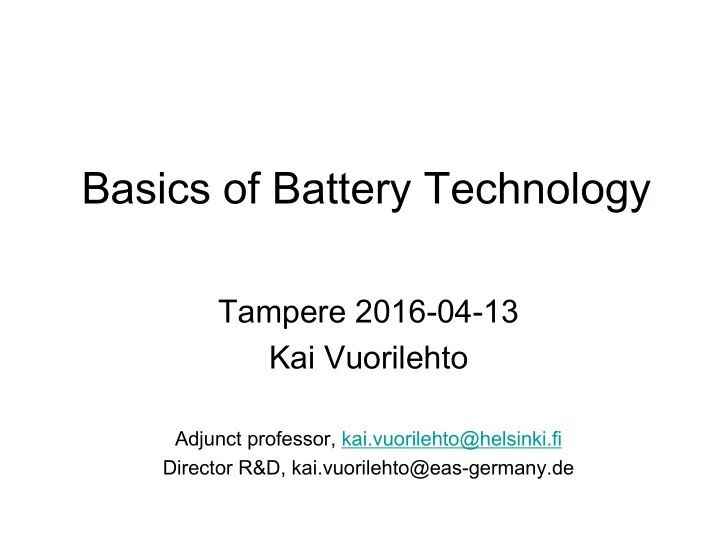

Basics of Battery Technology Tampere 2016-04-13 Kai Vuorilehto Adjunct professor, kai.vuorilehto@helsinki.fi Director R&D, kai.vuorilehto@eas-germany.de
Secondary batteries - chemistries • Pb-PbO 2 • NiOOH-Cd mostly forbidden • NiOOH-MH • Li-ion (C-CoO 2 )
Secondary batteries - energy • Pb-PbO 2 35 Wh/kg • NiOOH-Cd 35 Wh/kg • NiOOH-MH 75 Wh/kg • Li-ion (C-CoO 2 ) 150 Wh/kg
Wh/kg and W/kg
Secondary Batteries - characteristics • Voltage • Cost • Wh/kg • Safety • Wh/L • Environment • W/kg • W/L • Cycle life • Min. temp • Calendar life • Max. temp • Charge retention • Voltage profile • Charge acceptancy • Shelf life • Energy efficiency
Principle of the lithium-ion battery
Principle of the lithium-ion battery • NOT a lithium battery, as there is no metallic lithium • Metallic lithium could form dendrites and cause short circuit • Lithium ions are intercalated in host lattices (graphite etc.) • Each ion has its "own home"
Properties of lithium-ion batteries • High energy density • Rather high power density • Long cycle life • Good charge retention • High energy efficiency
Positive electrode (cathode) • Cobalt oxide – standard material, 3.7V (combined with graphite) – expensive, toxic and dangerous – layered structure – Co(IV) -> Co(III) at discharge – can be charged only 50%, Li 0.5 CoO 2 • for 7g of Li the electrode has 189g of extra Li 0.5 CoO 2 • collapses without lithium – thermal runaway – positive potential at the upper end of the electrolyte stability window
Negative electrode (anode) • Graphite LiC 6 – standard material (earlier coke) – Litium is intercalated between graphene layers – for 7g of Li the electrode has 72g of extra C – high voltage, 3.7V with CoO 2 – negative potential can cause lithium plating • Li + +e - -> Li(metal) – negative potential is outside the electrolyte stability window
Electrolytes • Ethylene carbonate & its derivatives as solvent • Lithium hexafluorophosphate LiPF 6 as salt – reaction with water gives HF • Hardly any alternatives – a strong solid electrolyte interphase (SEI) is needed on the graphite surface to prevent electrolyte decomposition • Lithium polymer batteries can use polymer electrolytes
What should be better? • Safety – Lithium plating – CoO 2 collapse – Thermal runaway – SEI layer destruction • Price – Cobalt – Electrolyte • Calendar life – SEI layer destruction • Environmental impact – Cobalt
Positive electrodes (cathodes) • Mixed oxides LiNi 1-x-y Co x M y O 2 – Cobalt oxide like materials, about 3.7V – NMC (LiNi 1/3 Mn 1/3 Co 1/3 O 2 ) less expensive & less dangerous – NCA (LiNi 0.8 Co 0.15 Al 0.05 O 2 ) higher capacity, dangerous • Mn and Al do not react, but prevent overcharge • LMO = Manganese oxide = LiMn 2 O 4 – three-dimensional spinel structure, 3.8V – cheap, environmentally friendly – less dangerous – Mn(IV) -> (III) at discharge – 2Mn(III) -> Mn(II) + Mn(IV) • soluble Mn 2+ destroys SEI layer on graphite
Positive electrodes (cathodes) • LFP = Iron phosphate = LiFePO 4 – three-dimensional olivine structure, 3.2V – can be fully charged to almost Li 0.0 FePO 4 – extremely stable, negligible lattice changes – fast charge and discharge, Fe(III) -> Fe(II) at discharge – natural product – lower energy density – low conductivity
Wrong positive electrode? Boeing dreamliner 2013
Negative electrodes (anodes) • LTO = Titanate Li 4 Ti 5 O 12 – extremely stable – fast charge and discharge – inside the electrolyte stability window, no SEI needed – cheap when combined with Mn 2 O 4 – low voltage, about 2V with CoO 2 » (promising for hybrid use?) • Tin Li 4.4 Sn – alloy, not intercalating material – for 7g of Li the electrode theoretically needs 27g of Sn – extremely unstable due to volume change
Electrode material summary • Positive electrodes – LCO traditional, expensive, unsafe – NMC cheaper, safer – NCA cheaper, highest energy – LMO very cheap & safe, short lifetime – LFP cheaper, very safe, lower energy • Negative electrodes – Graphite traditional, unsafe – Titanate very safe, very low energy – Tin & silicon high energy, very short lifetime
Materials for electric cars • NMC (+LMO) /graphite – Most electric vehicles • NCA/graphite – Tesla, small cells • LFP/graphite – Fisker Karma • NMC/titanate? – Mitsubishi MiEV
Future materials • Lithium-sulfur – Lithium metal – Sulfur is cheap – After my retirement • Lithium-air – Oxygen is in the air – Low mass – Pure science fiction
Recommend
More recommend